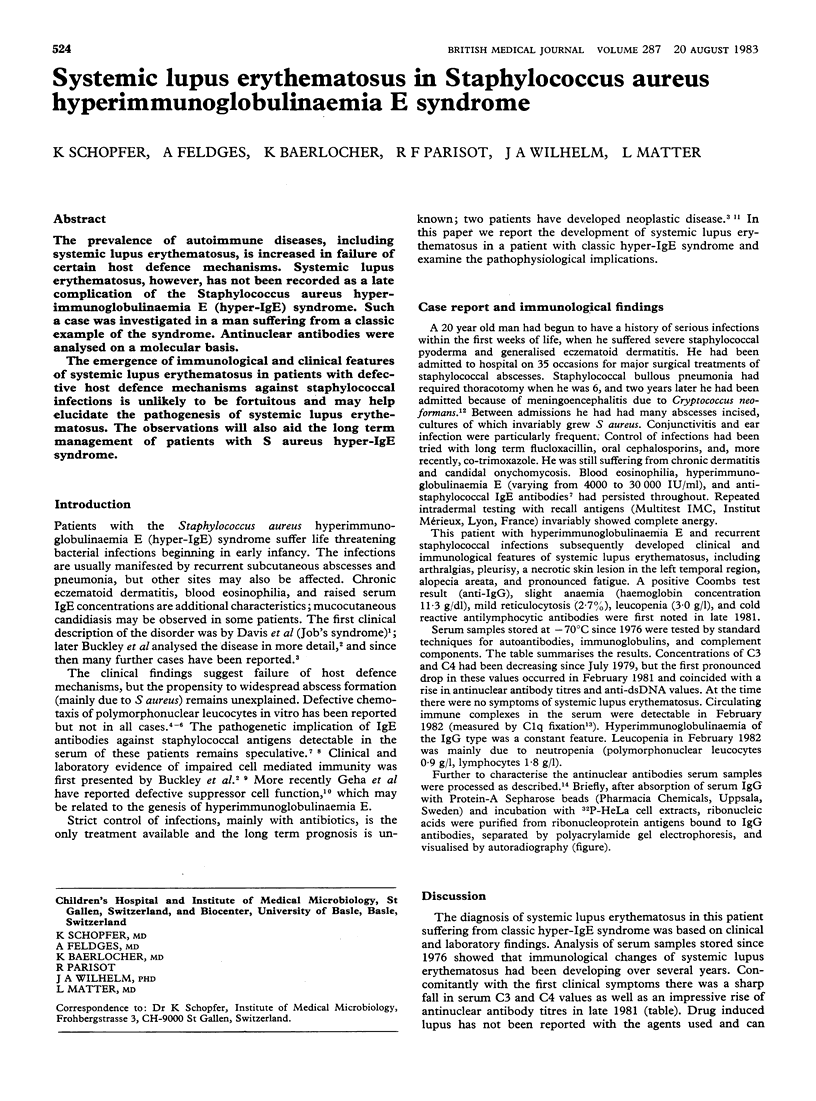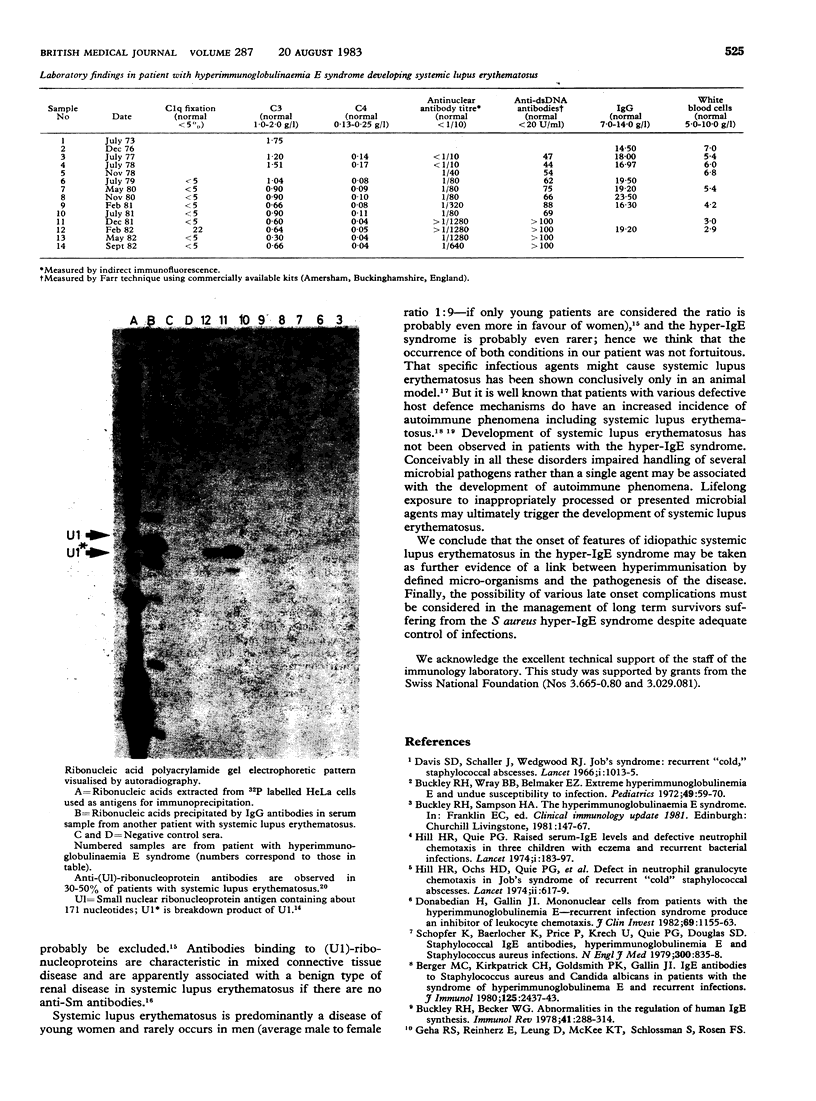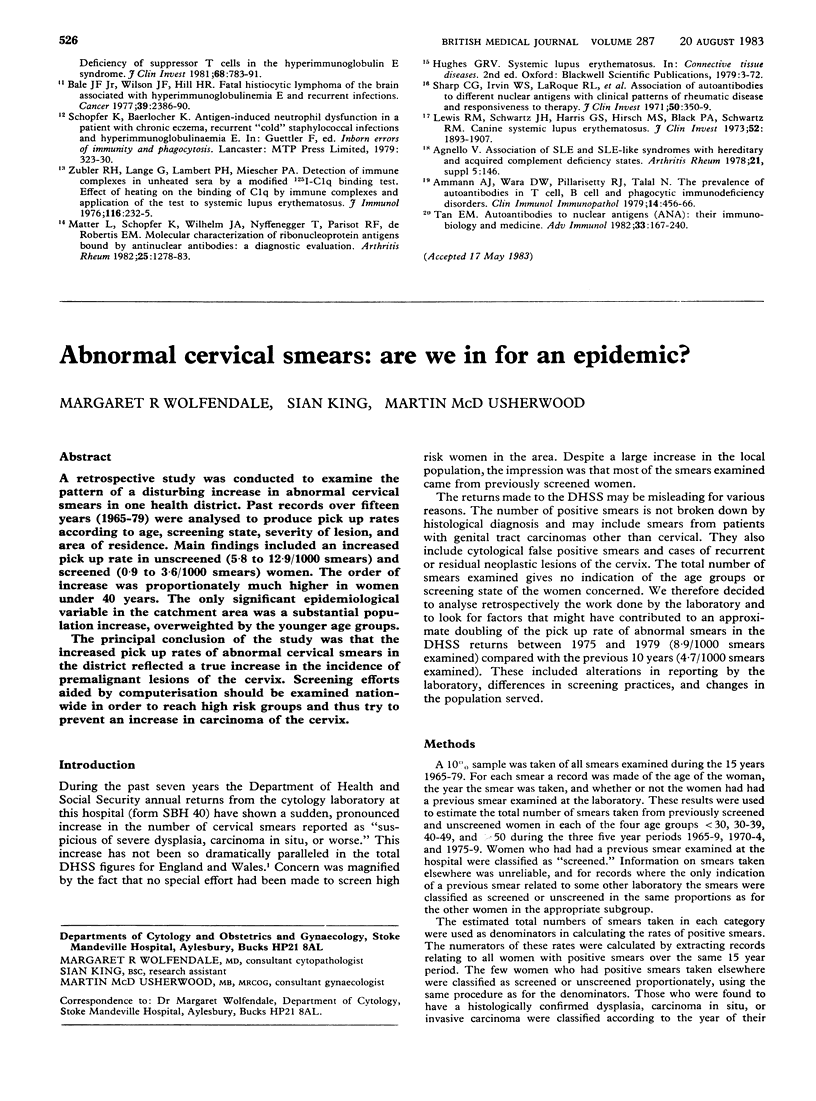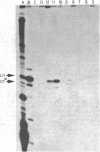Abstract
The prevalence of autoimmune diseases, including systemic lupus erythematosus, is increased in failure of certain host defence mechanisms. Systemic lupus erythematosus, however, has not been recorded as a late complication of the Staphylococcus aureus hyperimmunoglobulinaemia E (hyper-IgE) syndrome. Such a case was investigated in a man suffering from a classic example of the syndrome. Antinuclear antibodies were analysed on a molecular basis. The emergence of immunological and clinical features of systemic lupus erythematosus in patients with defective host defence mechanisms against staphylococcal infections is unlikely to be fortuitous and may help elucidate the pathogenesis of systemic lupus erythematosus. The observations will also aid the long term management of patients with S aureus hyper-IgE syndrome.
Full text
PDF


Images in this article
Selected References
These references are in PubMed. This may not be the complete list of references from this article.
- Ammann A. J., Wara D. W., Pillarisetty R. J., Talal N. The prevalence of autoantibodies in T-cell, B-cell, and phagocytic immunodeficiency disorders. Clin Immunol Immunopathol. 1979 Dec;14(4):456–466. doi: 10.1016/0090-1229(79)90098-9. [DOI] [PubMed] [Google Scholar]
- Bale J. F., Jr, Wilson J. F., Hill H. R. Fatal histiocytic lymphoma of the brain associated with hyperimmunoglobulinemia-E and recurrent infections. Cancer. 1977 Jun;39(6):2386–2390. doi: 10.1002/1097-0142(197706)39:6<2386::aid-cncr2820390612>3.0.co;2-x. [DOI] [PubMed] [Google Scholar]
- Berger M., Kirkpatrick C. H., Goldsmith P. K., Gallin J. I. IgE antibodies to Staphylococcus aureus and Candida albicans in patients with the syndrome of hyperimmunoglobulin E and recurrent infections. J Immunol. 1980 Dec;125(6):2437–2443. [PubMed] [Google Scholar]
- Buckley R. H., Becker W. G. Abnormalities in the regulation of human IgE synthesis. Immunol Rev. 1978;41:288–314. doi: 10.1111/j.1600-065x.1978.tb01469.x. [DOI] [PubMed] [Google Scholar]
- Buckley R. H., Wray B. B., Belmaker E. Z. Extreme hyperimmunoglobulinemia E and undue susceptibility to infection. Pediatrics. 1972 Jan;49(1):59–70. [PubMed] [Google Scholar]
- Davis S. D., Schaller J., Wedgwood R. J. Job's Syndrome. Recurrent, "cold", staphylococcal abscesses. Lancet. 1966 May 7;1(7445):1013–1015. doi: 10.1016/s0140-6736(66)90119-x. [DOI] [PubMed] [Google Scholar]
- Donabedian H., Gallin J. I. Mononuclear cells from patients with the hyperimmunoglobulin E-recurrent infection syndrome produce an inhibitor of leukocyte chemotaxis. J Clin Invest. 1982 May;69(5):1155–1163. doi: 10.1172/JCI110551. [DOI] [PMC free article] [PubMed] [Google Scholar]
- Hill H. R., Ochs H. D., Quie P. G., Clark R. A., Pabst H. F., Klebanoff S. J., Wedgwood R. J. Defect in neutrophil granulocyte chemotaxis in Job's syndrome of recurrent "cold" staphylococcal abscesses. Lancet. 1974 Sep 14;2(7881):617–619. doi: 10.1016/s0140-6736(74)91942-4. [DOI] [PubMed] [Google Scholar]
- Hill H. R., Quie P. G. Raised serum-IgE levels and defective neutrophil chemotaxis in three children with eczema and recurrent bacterial infections. Lancet. 1974 Feb 9;1(7850):183–187. doi: 10.1016/s0140-6736(74)92493-3. [DOI] [PubMed] [Google Scholar]
- Lewis R. M., André-Schwartz J., Harris G. S., Hirsch M. S., Black P. H., Schwartz R. S. Canine systemic lupus erythematosus. Transmission of serologic abnormalities by cell-free filtrates. J Clin Invest. 1973 Aug;52(8):1893–1907. doi: 10.1172/JCI107373. [DOI] [PMC free article] [PubMed] [Google Scholar]
- Matter L., Schopfer K., Wilhelm J. A., Nyffenegger T., Parisot R. F., De Robertis E. M. Molecular characterization of ribonucleoprotein antigens bound by antinuclear antibodies. A diagnostic evaluation. Arthritis Rheum. 1982 Nov;25(11):1278–1283. doi: 10.1002/art.1780251102. [DOI] [PubMed] [Google Scholar]
- Schopfer K., Baerlocher K., Price P., Krech U., Quie P. G., Douglas S. D. Staphylococcal IgE antibodies, hyperimmunoglobulinemia E and Staphylococcus aureus infections. N Engl J Med. 1979 Apr 12;300(15):835–838. doi: 10.1056/NEJM197904123001506. [DOI] [PubMed] [Google Scholar]
- Sharp G. C., Irvin W. S., LaRoque R. L., Velez C., Daly V., Kaiser A. D., Holman H. R. Association of autoantibodies to different nuclear antigens with clinical patterns of rheumatic disease and responsiveness to therapy. J Clin Invest. 1971 Feb;50(2):350–359. doi: 10.1172/JCI106502. [DOI] [PMC free article] [PubMed] [Google Scholar]
- Tan E. M. Autoantibodies to nuclear antigens (ANA): their immunobiology and medicine. Adv Immunol. 1982;33:167–240. doi: 10.1016/s0065-2776(08)60836-6. [DOI] [PubMed] [Google Scholar]
- Zubler R. H., Lange G., Lambert P. H., Miescher P. A. Detection of immune complexes in unheated sera by modified 125I-Clq binding test. Effect of heating on the binding of Clq by immune complexes and application of the test to systemic lupus erythematosus. J Immunol. 1976 Jan;116(1):232–235. [PubMed] [Google Scholar]



